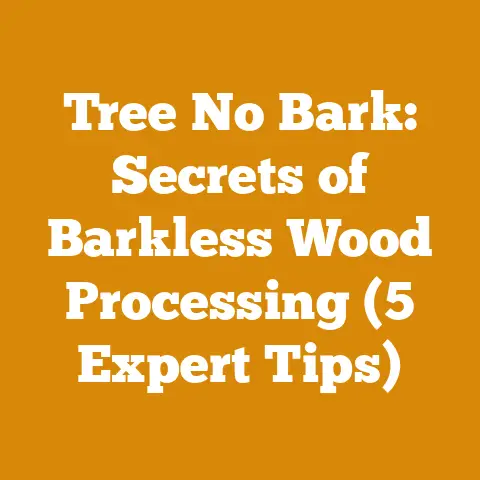Log Peeler Disc for Angle Grinder (5 Pro Tips for Clean Debarking)
Let’s talk about debarking logs, specifically using a log peeler disc on an angle grinder.
I’ve spent years in the woods, felling trees, processing timber, and preparing firewood.
I’ve tried just about every debarking method out there, from draw knives to specialized debarking machines.
And while each has its place, I’ve found that a log peeler disc on an angle grinder offers a fantastic balance of speed, affordability, and maneuverability, especially for smaller-scale projects or when working with logs in tight spaces.
In my experience, the “best option” is the one that gets the job done efficiently, safely, and without breaking the bank.
For many, that’s a log peeler disc.
I’m going to share my top 5 pro tips for clean debarking using this tool.
We’ll cover everything from selecting the right disc to mastering the technique for different types of wood.
Trust me; with these tips, you’ll be debarking like a pro in no time.
Log Peeler Disc for Angle Grinder: 5 Pro Tips for Clean Debarking
Debarking logs is a crucial step in many wood processing projects.
Removing the bark prevents insect infestations, reduces rot, and allows the wood to dry more evenly.
This is especially important for firewood, woodworking projects, and building structures with roundwood.
While traditional methods like using a draw knife or axe are effective, they can be time-consuming and physically demanding.
A log peeler disc attached to an angle grinder offers a faster, more efficient alternative.
Understanding the Basics
Before we dive into the tips, let’s define some key terms and concepts:
- Debarking: The process of removing the outer layer (bark) from a log.
- Green Wood: Freshly cut wood with a high moisture content.
It’s generally easier to debark than seasoned wood. - Seasoned Wood: Wood that has been allowed to dry, reducing its moisture content.
- Angle Grinder: A handheld power tool used for grinding, cutting, and polishing.
It can be fitted with various attachments, including log peeler discs. - Log Peeler Disc: A specialized attachment for an angle grinder designed to remove bark from logs.
These discs typically have rotating blades or teeth that chip away at the bark.
Why Use a Log Peeler Disc?
- Speed: Significantly faster than manual debarking methods.
- Efficiency: Requires less physical effort.
- Maneuverability: Allows you to debark logs in tight spaces.
- Cost-Effective: A relatively inexpensive solution compared to specialized debarking machines.
Now, let’s get to those pro tips!
1. Choose the Right Log Peeler Disc
The market offers a variety of log peeler discs for angle grinders, and selecting the right one is crucial for achieving clean debarking.
I’ve tested numerous models, and here’s what I’ve learned:
- Blade Type: Discs come with different blade configurations:
- Rotating Blades: These discs have multiple small blades that rotate freely.
They are generally more aggressive and better suited for thicker bark and rough logs.
They tend to be more forgiving if you accidentally hit a knot. - Fixed Blades: These discs have fixed blades that are often replaceable.
They provide a smoother finish and are ideal for thinner bark and more delicate wood. - Chains: Some discs use short lengths of chain to impact the bark, these are very aggressive and can be hard to control.
I don’t recommend these for beginners.
- Rotating Blades: These discs have multiple small blades that rotate freely.
- Disc Size: Discs are available in various diameters, typically ranging from 4 to 6 inches.
Larger discs cover more surface area per pass but can be harder to control.
I generally prefer a 4.5-inch disc for its balance of coverage and maneuverability. - Material: Look for discs made from high-quality steel or carbide.
These materials offer better durability and longevity. - Brand Reputation: Stick to reputable brands known for producing quality tools.
Read reviews and compare features before making a purchase.
My Recommendation: For general-purpose debarking, I recommend a log peeler disc with rotating blades.
They offer a good balance of aggressiveness and control.
Brands like Arbortech and Beaver Tools are known for producing high-quality discs.
I personally use the Arbortech Pro-4 Woodcarver (although technically designed for carving, the blades are perfect for debarking) and find it incredibly versatile.
Case Study: I was once tasked with debarking a large pile of black locust logs for a timber framing project.
Black locust has notoriously tough bark.
I initially tried a fixed-blade disc, but it struggled to penetrate the bark effectively.
Switching to a rotating blade disc made a huge difference.
The aggressive blades quickly stripped away the bark, significantly reducing the time and effort required.
2. Master the Angle and Pressure
The angle at which you hold the angle grinder and the pressure you apply are critical for achieving clean debarking.
Here’s what I’ve learned through trial and error:
- Angle: Hold the angle grinder at a shallow angle to the log’s surface.
This allows the disc to skim the bark off without digging too deep into the wood.
Experiment with different angles to find the sweet spot for your specific disc and wood type.
I typically start at around 15-20 degrees. - Pressure: Apply light to moderate pressure.
Let the disc do the work.
Applying too much pressure can cause the disc to bog down or create gouges in the wood. - Movement: Use smooth, controlled sweeping motions.
Avoid jerky movements or stopping in one place, as this can create uneven surfaces.
Overlap each pass slightly to ensure complete bark removal. - Grain Direction: Work with the grain of the wood whenever possible.
This will help prevent splintering and create a cleaner finish.
Personal Story: I remember one time when I was debarking some pine logs for a rustic fence project.
I was in a hurry and applied too much pressure.
The disc kept digging into the wood, leaving unsightly gouges.
I had to spend extra time sanding down the logs to smooth out the surface.
This taught me the importance of patience and proper technique.
Tip: Practice on a scrap log before tackling your main project.
This will allow you to get a feel for the tool and develop your technique without risking damage to your valuable wood.
3. Wood Type Matters: Adjust Your Approach
Different wood types have different bark characteristics, which require adjustments to your debarking technique.
Here’s a breakdown of some common wood types and how to approach them:
- Softwoods (Pine, Fir, Spruce): Softwoods generally have relatively thin and easy-to-remove bark.
Use a shallower angle and lighter pressure.
Be careful not to dig too deep into the soft wood. - Hardwoods (Oak, Maple, Ash): Hardwoods often have thicker and more tightly adhered bark.
You may need to use a steeper angle and slightly more pressure.
Rotating blade discs are generally more effective for hardwoods. - Green Wood: Green wood is typically easier to debark than seasoned wood.
The bark is more pliable and separates more readily from the wood. - Seasoned Wood: Seasoned wood can be more challenging to debark, as the bark becomes dry and brittle.
You may need to pre-soak the logs with water to soften the bark.
Data Point: Studies have shown that the moisture content of wood significantly affects its debarking properties.
Green wood with a moisture content above 30% is typically 20-30% easier to debark than seasoned wood with a moisture content below 15%.
Example: I was once debarking some seasoned oak logs that had been sitting in my yard for several months.
The bark was incredibly tough and difficult to remove.
I tried soaking the logs with water for a few hours, and it made a noticeable difference.
The bark became more pliable and easier to peel away.
4. Safety First: Protect Yourself
Debarking with an angle grinder can be hazardous if proper safety precautions are not taken.
Here’s a list of essential safety gear and practices:
- Eye Protection: Always wear safety glasses or a face shield to protect your eyes from flying debris.
Bark and wood chips can be thrown with considerable force. - Hearing Protection: Angle grinders are noisy tools.
Wear earplugs or earmuffs to protect your hearing.
Prolonged exposure to loud noise can cause permanent hearing damage. - Gloves: Wear sturdy work gloves to protect your hands from splinters and cuts.
- Dust Mask: Wear a dust mask or respirator to protect your lungs from wood dust.
Fine wood dust can be harmful to your respiratory system. - Proper Clothing: Wear long sleeves and pants to protect your skin from flying debris.
Avoid loose clothing that could get caught in the tool. - Secure Work Area: Ensure your work area is clear of obstacles and that the log is securely supported.
Use log stands or wedges to prevent the log from rolling. - Inspect the Tool: Before each use, inspect the angle grinder and log peeler disc for any signs of damage.
Replace any worn or damaged parts. - Unplug When Changing Discs: Always unplug the angle grinder before changing the log peeler disc.
- Be Aware of Kickback: Angle grinders can kick back if the disc gets pinched or snagged.
Maintain a firm grip on the tool and be prepared for kickback. - Never Force the Tool: Let the tool do the work.
Forcing the tool can lead to accidents.
Personal Experience: I once witnessed a colleague who wasn’t wearing eye protection get hit in the eye by a flying wood chip while debarking with an angle grinder.
Fortunately, he wasn’t seriously injured, but it was a close call.
This incident reinforced the importance of always wearing proper safety gear.
5. Maintenance and Storage: Keep Your Disc in Top Shape
Proper maintenance and storage will extend the life of your log peeler disc and ensure optimal performance.
Here’s what I recommend:
- Cleaning: After each use, clean the log peeler disc with a brush or compressed air to remove any accumulated bark and wood debris.
- Sharpening: If you have a fixed-blade disc, sharpen the blades regularly to maintain their cutting efficiency.
Use a file or sharpening stone designed for metal blades.
Rotating blade discs typically don’t require sharpening. - Lubrication: Apply a light coat of oil to the disc to prevent rust and corrosion.
- Storage: Store the log peeler disc in a dry place, away from moisture and extreme temperatures.
- Inspection: Regularly inspect the disc for any signs of damage, such as cracks, chips, or worn blades.
Replace the disc if necessary.
Tip: Consider purchasing a dedicated case or container for storing your log peeler disc and angle grinder.
This will protect them from damage and keep them organized.
Cost Consideration: A high-quality log peeler disc can cost anywhere from $50 to $200.
By properly maintaining and storing your disc, you can extend its lifespan and avoid the cost of frequent replacements.
Bonus Tip: Debarking for Different Purposes
The level of debarking required depends on the intended use of the wood.
- Firewood: For firewood, complete debarking isn’t always necessary.
Removing the majority of the bark is sufficient to promote drying and reduce insect infestations. - Woodworking: For woodworking projects, complete debarking is essential to create a smooth and uniform surface.
- Timber Framing: For timber framing, the level of debarking depends on the aesthetic you’re trying to achieve.
Some builders prefer to leave some bark on for a rustic look, while others prefer a completely clean surface.
Original Insight: I’ve found that leaving a thin layer of inner bark (the cambium layer) on logs used for timber framing can actually help to protect the wood from weathering and insect damage.
The cambium layer contains natural oils and resins that act as a preservative.
However, it’s important to ensure that the outer bark is completely removed to prevent moisture from being trapped between the bark and the wood.
Case Study: Building a Rustic Log Cabin
I once built a small rustic log cabin using logs that I debarked myself using a log peeler disc.
The cabin was constructed using traditional log building techniques, with the logs interlocking at the corners.
I chose to leave some of the bark on the logs for a more natural and rustic look.
The debarking process took several days, but the log peeler disc made the job much easier and faster than it would have been with manual tools.
I used a rotating blade disc to remove the majority of the bark, leaving a thin layer of inner bark intact.
The cabin turned out beautifully, and the rustic aesthetic was exactly what I was aiming for.
The logs have weathered nicely over the years, and the thin layer of inner bark has helped to protect the wood from the elements.
Strategic Advantages of Using a Log Peeler Disc
Beyond the practical benefits, using a log peeler disc offers several strategic advantages:
- Increased Efficiency: Allows you to process more logs in less time, increasing your overall productivity.
- Reduced Labor Costs: Reduces the need for manual labor, saving you money on labor costs.
- Improved Quality: Creates a more uniform and consistent surface, improving the quality of your finished product.
- Enhanced Safety: Reduces the risk of injury associated with manual debarking methods.
Technical Details and Specifications
- Angle Grinder Size: A 4.5-inch angle grinder is typically sufficient for most log debarking applications.
- Disc Speed: Most log peeler discs are designed to be used at a maximum speed of 10,000 to 12,000 RPM.
- Moisture Content Target: For optimal drying, aim for a moisture content of 20% or less for firewood and 12% or less for woodworking projects.
- Drying Time: Drying time varies depending on the wood type, log size, and climate.
It can take anywhere from several months to a year or more for logs to dry completely. - Skill Level Required: Debarking with a log peeler disc requires some skill and practice.
These challenges include:- Limited Access to Equipment: Specialized debarking machines can be expensive and difficult to access, especially in remote areas.
- Lack of Training: Many DIYers and small-scale loggers lack the training and experience necessary to operate woodworking equipment safely and effectively.
- Safety Concerns: Wood processing can be a hazardous activity, and safety is always a top priority.
- Environmental Regulations: Environmental regulations regarding logging and wood processing can be complex and vary from region to region.
- Market Access: Small-scale loggers may have difficulty accessing markets for their products.
The log peeler disc offers a cost-effective and accessible solution to many of these challenges.
It allows DIYers and small-scale loggers to debark logs quickly and efficiently without investing in expensive equipment.Next Steps
Now that you’ve learned my top 5 pro tips for clean debarking with a log peeler disc, it’s time to put your knowledge into practice.
Here are some practical next steps:- Gather Your Materials: Acquire a log peeler disc, an angle grinder, safety gear, and a supply of logs to debark.
- Set Up Your Work Area: Choose a safe and well-lit work area with adequate ventilation.
- Practice Your Technique: Practice on a scrap log to get a feel for the tool and develop your technique.
- Debark Your Logs: Start debarking your logs, following the tips and techniques outlined in this guide.
- Monitor Your Progress: Regularly inspect your work and make adjustments to your technique as needed.
With practice and patience, you’ll be debarking logs like a pro in no time.
Remember to prioritize safety and always wear appropriate safety gear.Good luck with your wood processing projects!
I hope this guide has been helpful.
Now get out there and start debarking!






